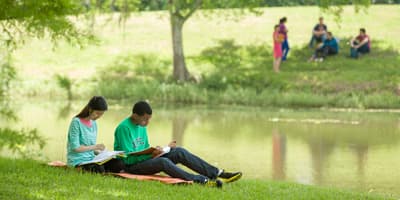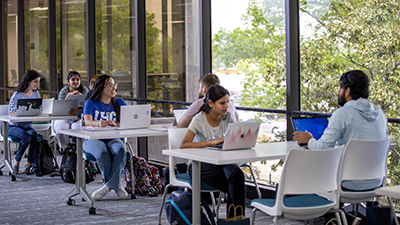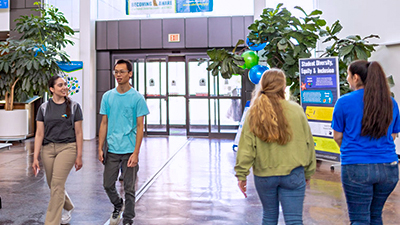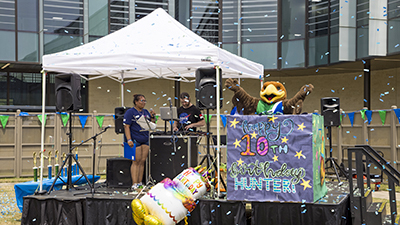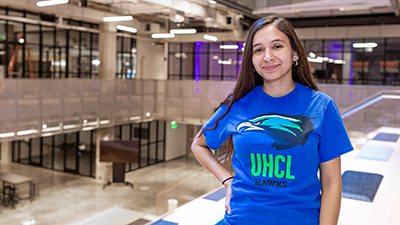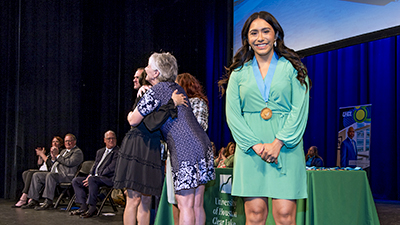Public art at UHCL adds beauty and history to campus
University of Houston-Clear Lake prides itself on its inclusion of art throughout the campus. It’s hard to miss “Spiritus Mundi,” the bronze sculpture that sits in front of the Bayou Building or the marble “The Ocean” structure on the second floor of the Bayou Building. The Art Gallery and wall mural in the Bayou Building near the Patio Café also have a strong presence on campus, drawing the gaze of dozens of passersby every day.
But there are many other works of art, large and small, that don’t always get the same recognition. Some are tucked away in areas of campus that don’t receive a lot of foot traffic or in buildings that many students and employees never have a reason to visit. Others do receive a lot of traffic, but only from a distance.
Some of the art pieces on campus have a permanent home at UH-Clear Lake while others are on display temporarily as part of a public art exhibition. Regardless of how they got to UHCL, each tells a unique story. Each speaks to its audience in different ways, and all should be celebrated. Here are just a few of the secluded art pieces on campus worthy of a visit:
“Steel Study,” 1977
With its combination of round and straight edges and reflective surface, this sculpture sits boldly in the STEM Building lobby as part of Public Art of the University of Houston System’s temporary exhibition. Artist William Crovello created this stainless-steel structure in 1977 after learning classical calligraphy while serving in the U.S. Air Force in Japan and Korea in the ‘50s. Feeling inspired by the artistic elements in this writing style, he often included them in his sculptures, including his “Steel Study.”
“The Firebird,” 1978
Nestled on the lawn near the rear entrance to the Bayou Building is this sculpture made from welded cor-ten steel in 1978 by world-renowned sculptor Richard Hunt. Also a talented metalworker and welder, Hunt created this and other pieces to demonstrate his interest in forming hybrid figures “derived from anthromorphic, zoomorphic, or plant-based forms.”
His creations span over seven decades and have been featured all over the country. Dozens of cars drive past “The Firebird” daily, but since it can blend in with the adjacent trees, it takes some intentional observation, on foot, to truly appreciate it. This sculpture was added to the campus, courtesy of Public Art of University of Houston System.
Untitled running figure, circa 2008
This untitled artwork can be found behind the Arbor Central Building, courtesy of a UHCL student enrolled in the Bachelor of Fine Arts program. Associate Professor of Art Jason Makepeace shared his recollection of the piece. “The running figure was created in ceramics by an international exchange student from Czech Republic more than 15 years ago,” he said. “He worked with former ceramic professor Nick de Vries and was a part of the former international arts consortium which was ran by Nick and Sandra Hu.”
Untitled metal sculptures, circa 2011
According to Makepeace, these sculptures were created about 12 years ago. “The figure was created by Jason Shaw, and the three folded paper style planes were created by Cameron Rowe,” he said. “Jason and Cameron are local and are BFA alumni, and their pieces were created under my guidance in ARTS 4311 Process Sculpture.”
The hollow figure features elements akin to a human skeleton, with a ribcage protecting a large heart. The airplanes portray the clever artistic contradiction of paper airplanes, made out of metal. Both can be found next to each other behind the Arbor Central Building.
“Moldable Subtractions,” 2014
Every student who has taken a course in any of the Arbor Buildings since 2014 has likely walked past this towering red figure near the Arbor Building sidewalks and parking lot. Others who have noticed it have seen only from the parking lot or street. Made of concrete and powder coated steel, this work of art reflects the personal interests of its creator, who happens to be Makepeace.
An experienced kayaker, Makepeace fashioned this piece to celebrate his fascination with the continuity of the basic design of the kayak, despite centuries of technological advancements. “Representing the underlying structure of a modern kayak, Makepeace uses red to heighten and to give a bold and balanced contrast to its base, which has been made to resemble a tree stump. This juxtaposition of these two forms results in the illusion of the kayak being carved straight from the tree,” the plaque reads.
